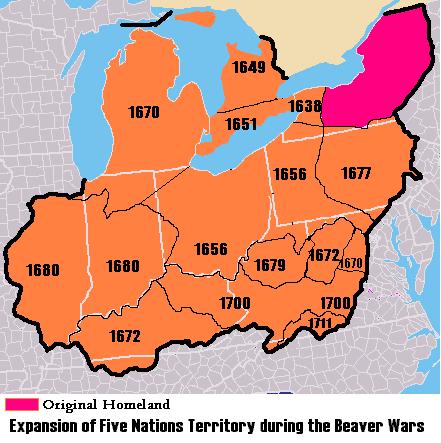During the mid-seventeenth century, in an attempt to dominate the fur trade as well as the trade between European markets and tribes of the western Great Lakes region, the Iroquois, supplied with Dutch and English firearms, aggressively expanded their territory westward (“Potawatomi,” 2019, p. 1). The French, economically dependent on the fur trade, aligned with the Algonquian-speaking tribes in the area to defend their hold on the precious commodity. This aggression resulted in several conflicts between the Iroquois Confederation, primarily Mohawk (one of the five core tribes of the Iroquois Confederacy), and most of the Algonquian-speaking tribes of the Great Lakes territory (“Potawatomi,” 2019, p. 1).
History recalls this bloody period as the French and Iroquois Wars; however, they were informally known as the “Beaver Wars.” While the title seems unassuming, the wars were ferocious and are still considered some of the bloodiest conflicts in North America’s history (“Potawatomi,” 2019, p. 1). The continent’s tribal geography was realigned because of the Iroquois’ push westward, which resulted in the destruction of several large tribal confederacies, including the Hurons, Neutrals, Eries, and Susquehannocks. Many other eastern tribes were pushed west of the Mississippi River (“Potawatomi,” 2019, p. 1).

Additionally, the Beaver Wars severely disturbed the Algonquian societies of the Great Lakes. The Potawatomi moved northward into Wisconsin through Michigan’s Upper Peninsula around 1665 to avoid the battles (Milwaukee Public Museum, n.d., p. 1; “Potawatomi,” 2019, p. 2). To adapt to their new home living on the western shores of Lake Michigan, the Potawatomi learned to successfully grow corn, gather wild rice, and harvest fish and waterfowl (“Potawatomi,” 2019, p. 2).
One of the Beaver Wars’ primary drivers was the French dependence on the fur trade. They welcomed any delivery of hides to their base in Montreal. Responding to the Iroquois’ attempt to dominate the fur trade, the Wyandot and Ottawa Tribes used Chippewa warriors to help them deliver pelts to Montreal. In retribution, the Iroquois responded by attacking any tribe in Wisconsin and upper Michigan that was discovered supplying fur to the Algonquin middlemen (“Potawatomi,” 2019, p. 2).
This chain of events birthed conflicts that pushed more than 20,000 refugees into the region surrounding Wisconsin’s Door Peninsula (“Potawatomi,” 2019, p. 1). This area was too small to support the refugee influx. These tribes soon suffered epidemics, starvation, and fought amongst themselves for the scarce hunting ground on the peninsula (“Potawatomi,” 2019, p. 1). Fortunately, the Potawatomi were located directly on the Door Peninsula, isolating them from the surrounding tribes and their accompanying troubles (Milwaukee Public Museum, n.d., p. 1; “Potawatomi,” 2019, p. 2).
The protection the Potawatomi received on the peninsula allowed them to more easily maintain their tribal unity. Simultaneously, the larger surrounding tribes (Illinois, Kickapoo, Mascouten, Menominee, Miami, Nipissing, Noquet, Ottawa, Sauk Fox, Winnebago, Wyandot, and several bands of Chippewa) separated into mixed villages. Over time, the Potawatomi grew to become the dominant tribe in the region (“Potawatomi,” 2019, p. 2).

Chivis, J. (2018). The History of the Nottawaseppi Huron Band of the Potawatomi. Presented at the Colon Township Library. Colon Township Library.
Forced Migration by Iroquois Nation During the Beaver Wars. (n.d.). Oxford University Press. Retrieved from http://detroiturbanism.blogspot.com/2016/03/indian-villages-reservations-and-removal.html
Iroquois Expansion During Beaver Wars: 1638-1711. (2011). Creative Commons. Retrieved from http://www.brooklineconnection.com/history/Facts/Indians.html
Michigan State University. (n.d.). Location of Tribes, 1670.
Milwaukee Public Museum. (n.d.). Potawatomi History. Retrieved from Potawatomi History website: http://www.mpm.edu/content/wirp/ICW-152
Native Americans of the Eastern Ohio Country. (n.d.). Retrieved from http://www.brooklineconnection.com/history/Facts/Indians.html
Potawatomi. (2019). In New World Encyclopedia. New World Encyclopedia. Retrieved from https://www.newworldencyclopedia.org/p/index.php?title=Potawatomi&oldid=1015500
Sewick, P. (2016). Detroit Urbanism: Indian Villages, Reservations, and Removal. Retrieved from Detroit Urbanism website: http://detroiturbanism.blogspot.com/2016/03/indian-villages-reservations-and-removal.html

